#autism camouflaging
Text
Understanding the What, Why and How of Autism Masking
What is Autism Masking?
Autism masking, also called autism camouflaging or autism neurodivergent masking, describes the conscious or subconscious effort by autistic people to suppress their autistic traits and behaviors to appear neurotypical i.e. non-autistic.
Autism masking is a coping mechanism used by individuals with autism to hide their autism symptoms to either fit into or better navigate social situations.
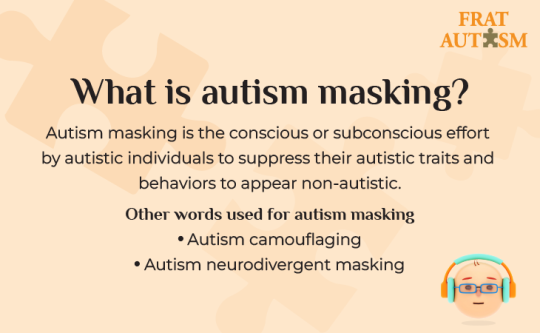
What Does Autism Masking Look Like?
Imagine you’re playing dress-up. You put on a costume, maybe a superhero cape or a pirate hat, to fit in with the game. That is kind of what “masking” is in autism. Some autistic people act differently in social situations than they do naturally, like wearing a “social costume” to fit in.
But underneath that costume are their autistic traits, their unique way of thinking and experiencing the world. It’s like their superpowers! This table shows some differences between these “superpowers” and the “costume” some people choose to wear:
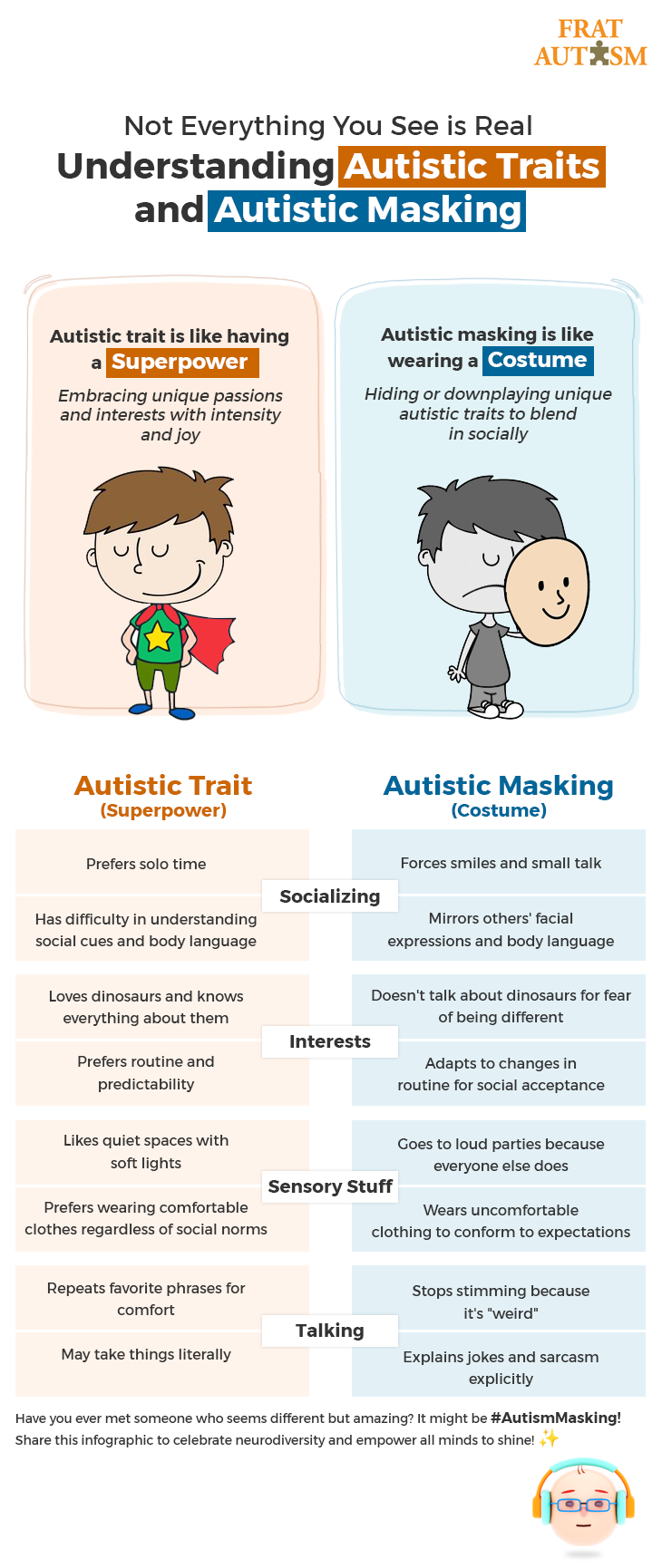
Remember, not every autistic individual wears a costume all the time, and the costume can look different for each person. The most important thing is to be kind and understanding of everyone, no matter what “costume” they wear!
Why Do Autistic People Mask?
Imagine living in a world where your natural way of interacting, processing information, and experiencing joy makes you stand out. Imagine the subtle (and sometimes not-so-subtle) cues that tell you you’re “different,” that your unique perspective isn’t always welcome. This, unfortunately, is the reality for many autistic individuals who engage in masking, a complex phenomenon where they adapt their behavior to conform to social expectations.
The core driver behind masking lies in the universal human desire for belonging and acceptance. We are innately wired to connect with others, and rejection stings deeply. Autistic individuals, unfortunately, often face social rejection due to their neurodivergent traits. Stimming behaviors, sensory sensitivities, and even blunt honesty can be misconstrued as “weird” or “inappropriate” by neurotypical individuals, leading to ostracism and bullying. To navigate this challenging social landscape, many autistic individuals choose to mask their natural behaviors.
Understanding why autistic people mask is crucial for building a more inclusive and accepting world. By recognizing the inherent desire for connection and the challenges faced due to neurodivergence, we can create spaces where autistic individuals feel safe to express themselves authentically, without fear of rejection or judgment.
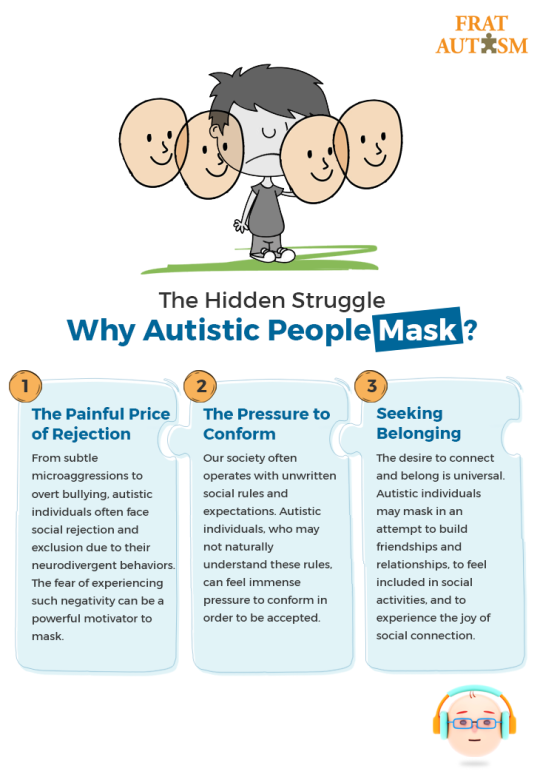
Is Autistic Masking Good?
It’s crucial to remember that masking is not a choice but a coping mechanism. While masking can offer some short-term relief from social anxieties, it comes at a significant cost.
Mental Health Impact: Masking can be mentally and emotionally draining, leading to anxiety, depression, and burnout. Suppressing one’s authentic self for extended periods can take a toll on self-esteem and well-being.
On Stress & Anxiety: The 2019 study on Understanding the Reasons, Contexts and Costs of Camouflaging for Autistic Adults[1] revealed higher stress and anxiety in people who masked autistic traits frequently compared to those who masked less often.
On Depression: In 2018, research (Experiences of Autism Acceptance and Mental Health in Autistic Adults)[2] revealed that autistic adults who masked their traits more often were more likely to experience depression and feel socially ostracized.
Exhaustion: A 2016 NIH study[3] found that autistic women who masked their traits to conform to neurotypical expectations reported feeling exhausted by the constant effort.
Loss of Identity: Masking can create a disconnect between an individual’s true self and the persona they present to the world. This can lead to feelings of inauthenticity and confusion about one’s identity.
Limited Potential: Masking can prevent autistic individuals from fully expressing their unique strengths and talents. By hiding their true selves, they may miss opportunities to connect with others who share their interests and perspectives.
Perpetuating Stereotypes: Masking reinforces the idea that there is only one “right” way to be social, further marginalizing autistic individuals and their unique experiences.
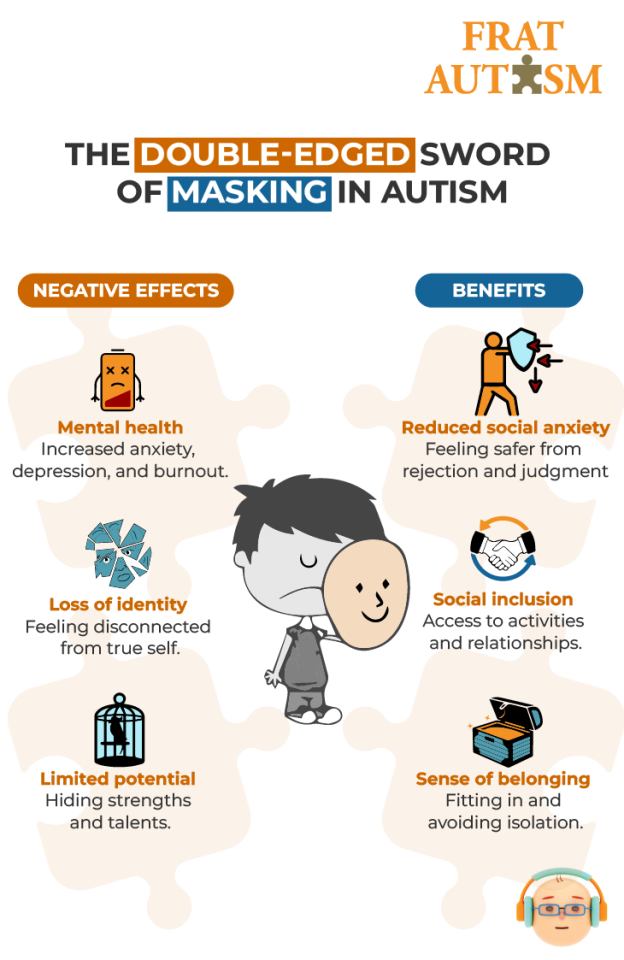
1 note
·
View note
Text


Aww she's shy 🙈
#autism memes#autism meme#autistic memes#camouflaging#autistic masking#autism things#autistic problems#autistic women#autistic girls#i'm shy#autism in women#undiagnosed autistic#autism in girls#late diagnosed autistic#autistic adult#autistic woman#autistic girl#shy#late diagnosis#neurodivergent#autism#actually autistic#autism diagnosis#undiagnosed autism#girls with autism#women with autism#autism spectrum#psychology#psychology memes#ineedfairypee
330 notes
·
View notes
Text
Hi everyone,
I found an interesting study on females with autism and how tools are more male-based tools. According to this study:
An Australian-first study from Flinders University has found women and girls are harder to diagnose with autism than boys, because diagnostic tools are skewed towards detecting autistic boys and men.
The researchers found autistic girls and women often mask their traits and are not being diagnosed until later in life, if at all, meaning they miss out on important supports.
"The tools we currently use are not well-equipped to diagnose autism in females and we need to go back to the drawing board to work out how girls with autism present and how different they might be from ... boys," Professor Robyn Young said.
"If we've got a stereotypical view of what autism looks like and a female comes in with really good social scripts, good eye contact, engaged in pretend play, their obsessive interest is Harry Styles, they might not appear to be so different from any other female."
"Boys will often externalise their behaviours and become more obvious in the classroom, acting out and having meltdowns.
"Girls are more inclined to camouflage ... and as a result they don't come to the attention of professionals until much later."
The full article will be below for anyone who wants to read it.
#autism#actually autistic#autism in women#camouflage#masking#outdated tools#feel free to share/reblog#if you’re neurodivergent feel free to reblog
110 notes
·
View notes
Photo
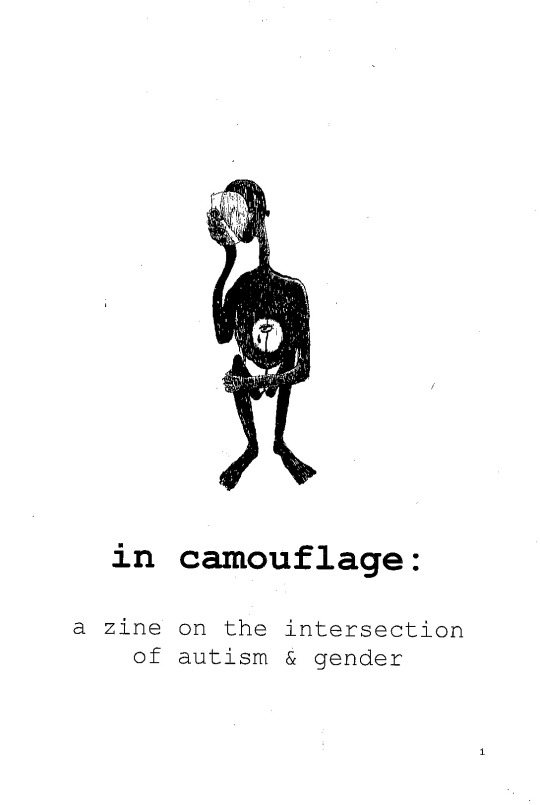
in camouflage
#in camouflage#Disabled Students Campaign#autism#autism and gender identity#gender identity#poetry#personal stories#zine#SDPL
44 notes
·
View notes
Photo
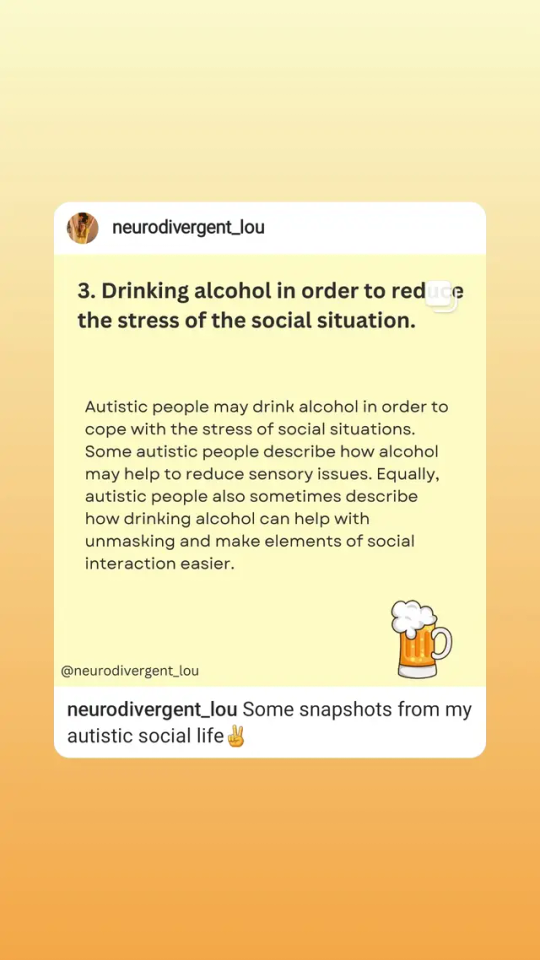
autistic traits
5 notes
·
View notes
Text
Deep compensation in Autism spectrum disorder (ASD)
I recently read about a particular thing people on the spectrum do that is rarely spoken about (when comparing to masking) and gets in the way of pople getting a formal asd diagnosis: deep compensation.
Livingst and Shah (2019) and Livingst et. al (2020) have written about it (links go to open access papers) and showed how it can disguise autism.
I'll share some quotes, from those papers, that I found interesting.
However, it is likely other, more sophisticated strategies involving deep compensation exist, such as detail-focused analysis of social information, which might allow a person to solve ToM and have fairly flexible social understanding, albeit via an atypical route.
We have previously hypothesised that these may be distinct from deep compensatory strategies, which work flexibly across contexts, because they provide an alternative route to the social-cognitive ability in question (e.g. theory of mind), for example, using complex mental algorithms to predict other people’s thoughts and feelings.
This would be akin to a visually impaired person using echolocation; the strategy does not simply circumvent the impairment like a white stick does, but provides an alternative way to form a spatial representation that enables navigation skills.
Strategies that enable an alternative route to solve the cognitive difficulty in question (e.g. successfully solve theory of mind, albeit differently to neurotypical people): Flexibly use built catalogue of possible interpretations of others’ mental states, based on a combination of multiple sources of information (e.g. logic, context, facial expression, tone of voice); substitute others’ values/interests with your own or those of a TV/book character to infer their mental state
When it comes to how asd are presented esp in afab individuals, camouflaging or masking is something that is often present. (You can test here if you score high or low on these, link goes to the CAT-Q test), in a nutshell the following table describes what each behaviour is:
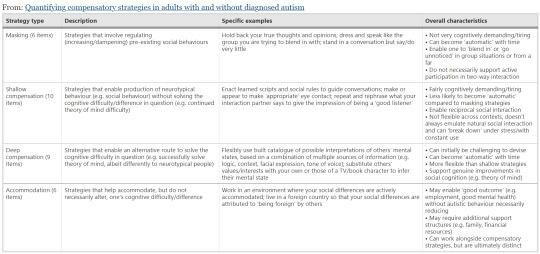
I have already come across most of this online (or in books) when reading about masking, but deep compensation strategies - in which a person can use a different part of the brain to perform a function, often solving intellectually what most people solve by instinct - were a new concept to me and helped me a lot, since it is often co-present with other strategies but was rarely talked about.

(Venn diagrams showing the number of a Diagnosed and b Non-diagnosed participants that reported using masking, shallow compensation, deep compensation and/or accommodation strategies. Overall, participants were more likely to report strategies across multiple types, than a single strategy type. This pattern was broadly similar between the two groups, but there was a significant group difference in shallow compensation)
The biggest take away is that, when this becomes an ingrained habit, people will be able to "understand" social cues and to deduce what people are thinking/feeling (especially when combined with acommodations in the environment) and this can come up as a failure to identify with a few traits people with asd have (but still feel autistic).
Deep compensation (subtheme), involving complex and flexible strategies, contributed to some improvements in social cognition. Some participants reported using pattern detection and internal data modelling (gesture + facial expression + context = particular mental state) to understand others. These strategies, although hard to implement at first, could become “second nature” with time.
To modulate compensatory efforts, many participants described compensating after logically assessing the costs versus benefits (subtheme). For example, compensation was considered worthwhile to make a positive impression towards a friendship, but not for interactions with inconsequential strangers. In superficial interactions, masking was preferred over compensatory strategies to conserve resources.
Compensation typically resulted in a lack of support in adulthood because participants looked “too normal” (subtheme). Employed participants reported that employers and colleagues held them to a neurotypical standard, which resulted in social errors not being interpreted in the context of autism. Because autistic characteristics went undetected by others, many participants reported that it was difficult to request, and they were unlikely to receive, workplace accommodations.
“I think I observe patterns in behaviour and then try to transfer this. So if a person is behaving x/y/z types of ways, they could be feeling or thinking what so and so people had felt. It's almost a case of systematically storing little patterns in each person and the context, so I can refer to it in future.”
There is another quote that I loved but simply cannot find rn. It must be somewhere in the papers or related literature, so I recommend reading it if you are willing. I also found some great charts last night that i can't locate rn.
Personally, I was quite shocked to find out that people take social cues by instinct, because i legit thought everyone deduced what people feel/think and it was second nature to them simply because they had more social interaction and were more at ease around people and therefore social interaction becomes better with time after you learn and become familiar with different behaviours and learn how to react. I thought this was the "normal way" people go through life and some were simply more skilled at it (learning faster and better at deducing). Well, it seems it is not the case. I can't make any good summary of the papers, but I hope the quotes I shared here can help some people as they have helped me.
#asd#actually autistic#masking#accommodation#compensation#deep compensation#theory of mind#autistic adult#late diagnosed autistic#autism#autistic masking#autistic community#camouflage#late diagnosed autism
107 notes
·
View notes
Quote
Noticing that the community here calls it masking more but the more I read from the literature to understand it the more I notice that it's called camouflaging.
Do y'all have a preference?
reblog and share your opinions?
2 notes
·
View notes
Text
computer, open RAADS-R and ADHD screening... its time to get to the bottom of this
#129 raads and 6/6 initial ADHD screening... maybe something neurodivergent is happening here...#also scored around 120 on camouflaging test hmmmmmm#should I go pay to get professionally tested for this shit or just be aware that i'm a little different and thats ok#idk i dont want to hop on the gen z tiktok neurospicy bandwagon but i have felt off since birth yk and autism does run on both sides#of the family and maybe being aware of that would do me some good anxiety wise#many thoughts to be thunk
2 notes
·
View notes
Photo
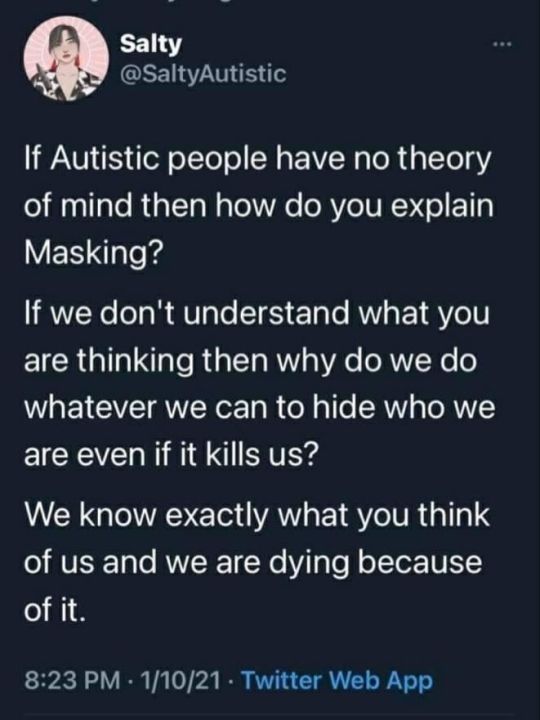
autism and theory of mind?? this is a theory and we’re talking about life experience here!
12 notes
·
View notes
Text
Burnout Recovery Woes
Ups and downs. Hoping to record some stuff this week but we'll have to see.....
#Burnout #BurnoutRecovery #HealingIsNotLinear #AutisticBurnout
Urgh. So, I’m definitely recovering.
Ssssllllooooowwwwwllllyyyyy���….
Have a few good days then a couple of bad ones.
Feel better, do something, feel worse again.
It’s so frustrating.
Healing is not linear
I know logically that healing/recovery isn’t linear but that doesn’t change how grim and upsetting it can be to not know from day to day how many spoons I have.
I’m really hoping to record…

View On WordPress
#Actually Autistic#Autism#Autistic#Autistic Adult#Autistic Adults#Autistic burnout#Autistic camouflage#Burnout#Burnout recovery#Fork theory#Healing#Healing isn&039;t linear#Late Diagnosed#Late Diagnosed Autistic#Recovery#Scripting#Spoon theory#Spoonie#Wellbeing
6 notes
·
View notes
Text
me after not seeing my friends for a long time: oh no my masks are failing what do i do :(
#im not funny nor articulate anymore help#i lost my filter too#autism#actually autistic#autism camouflage
3 notes
·
View notes
Text

自閉症スペクトラム小さい頃から集団生活の特異行動内省や感覚過敏トラウマ的体験,敏感にマスキング擬態化カモフラージュ対策等で過緊張高不安。加齢と疲労や緊張,背中の筋膜炎?腰痛。大人の発達障害アスペルガー/自閉スペクトラム症のA型作業所PC仕事。ASD光るもの魅了DSM-5診断基準,影と光加減を撮影
#snapseed#autism spectrum disorder#high functioning autism#high anxiety#very nervous#autistic masking#autistic camouflaging#traumatic experience
0 notes
Text
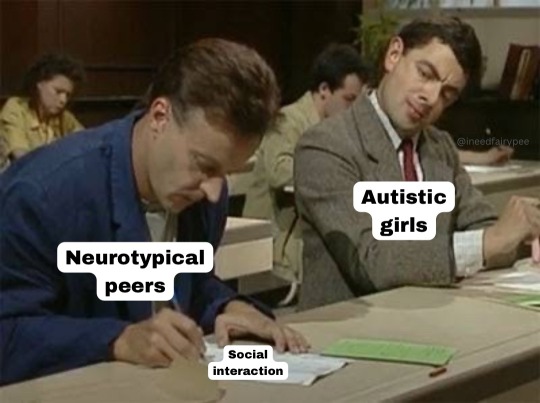
Fake it til you make it
#autism memes#actually autistic#autistic women#autistic girls#autistic problems#autistic life#neurodiversity#autistic things#girls with autism#autism community#women with autism#female autism#autism meme#autistic memes#autistic masking#autism things#autism#autistic community#autistic culture#psychology memes#psychology#autism diagnosis#undiagnosed autistic#undiagnosed autism#late diagnosed autistic#neurodivergent#camouflaging#late diagnosis#autism spectrum#ineedfairypee
365 notes
·
View notes
Text
Autism Appreciation Month: The Way of the Mask, Navigating the Neuroconvergent World
Being autistic in the neuronomral world is dangerous. If an autistic person wants to have a job or relationships with neuronormal people, we need to mask our autism. It is a sad reality.
Mia Culpa
Blogging and blogs are a fragile thing, especially when the blogger is a full-time citizen and only a part-time blogger as I am. When last we left it, I had returned from China with the four months of salary that #COVID-19 and ridiculous Chinese bureaucracy had forced me to leave there in 2020, but also, with a cold. The week after returning, I managed to get to work everyday, but was…

View On WordPress
#Autism#Autism Acceptance Month#Autism Appreciation Month#Autism Awareness Month#Body Language#Elements of Style#Exhaustion#Masking#Mia Culpa#Microaggressions#Neuroconvergent#Neurodivergent#PubMed Central#Sheldon Cooper#Social Camouflaging#Stress#Strunk and White
0 notes
Text


1 note
·
View note
Text
Exploring the link between hypermobility and neurodiversity
Like the princess and the pea, my hypersensitivity to factors that don’t even seem to register to other people means that the kind of bed that greets me when I check in somewhere new is a make or break situation. “Pretty” metal bed frames that creak and otherwise self-animate whenever you move, especially those with a load of wire springs underneath, under compensated for by over soft or springy…

View On WordPress
#actually autistic#adaptability#articles#autism#autistic challenges#autistic women#burnout#camouflaging#chronic health#dealing with change#familiarity#Hypermobility#masking#neurodiversity#poor sleep
0 notes